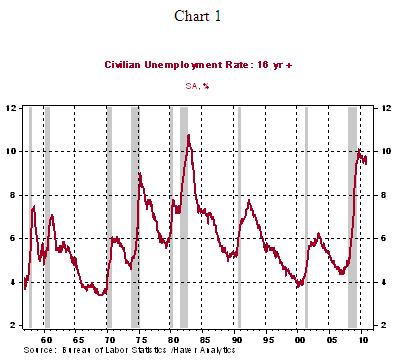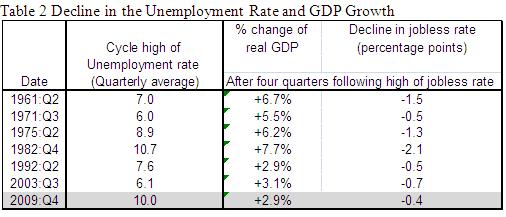How Fast Has the Jobless Rate Declined After Prior Recessions?
Economics / Unemployment Jan 25, 2011 - 01:53 AM GMTBy: Asha_Bangalore

 The 9.4% unemployment rate in December 2010, an elevated reading, is down from a high of 10.1% in October 2009. The recent cycle low for the unemployment rate was 4.4% in May 2007. Although each business cycle is different, it is still worthwhile to recall how fast the jobless rate has declined in the past 60 years after each recession.
The 9.4% unemployment rate in December 2010, an elevated reading, is down from a high of 10.1% in October 2009. The recent cycle low for the unemployment rate was 4.4% in May 2007. Although each business cycle is different, it is still worthwhile to recall how fast the jobless rate has declined in the past 60 years after each recession.
Highlights of the upward trend of the jobless rate provide a perspective before assessing the pace of the decline in the unemployment rate. The median increase in the jobless rate, following a recession, is 2.7 percentage points during 1960-2003. The unemployment rate has risen 5.7 percentage points in the recent downturn, which ended in June 2009; this is 3 percentage points higher than the historical median gain.


How fast does the unemployment rate decline? What explains the variations of the decline in the jobless rate across business cycles? The highs of the unemployment rate, on a quarterly average basis, for each recession, excluding the mini-recession of 1980, are listed in table 2. The jobless rate has declined at a differing pace as the economy has recovered, with the median decline as 1 percentage point during 1960-2003. By contrast, the decline in the unemployment rate this time around is only 0.4 percentage points after four quarters have lapsed from the cycle high jobless rate.
The growth rate of real GDP determines how rapidly the jobless rate falls. During 1960-2003, real GDP has risen 5.85% (median) at the end of four quarters after the unemployment rate has peaked. This time around there has been only a 2.9% increase in real GDP one year after the unemployment rate recorded the high for the cycle in the fourth quarter of 2009. (Assuming real GDP rose 3.6% in the fourth quarter of 2010). Projections of real GDP growth in the quarters ahead point to only a gradual decline of the jobless rate.

Asha Bangalore — Senior Vice President and Economist
http://www.northerntrust.com
Asha Bangalore is Vice President and Economist at The Northern Trust Company, Chicago. Prior to joining the bank in 1994, she was Consultant to savings and loan institutions and commercial banks at Financial & Economic Strategies Corporation, Chicago.
Copyright © 2011 Asha Bangalore
The opinions expressed herein are those of the author and do not necessarily represent the views of The Northern Trust Company. The Northern Trust Company does not warrant the accuracy or completeness of information contained herein, such information is subject to change and is not intended to influence your investment decisions.
© 2005-2022 http://www.MarketOracle.co.uk - The Market Oracle is a FREE Daily Financial Markets Analysis & Forecasting online publication.
Comments
|
dirk
25 Jan 11, 12:10 |
employment rate
Isn't the measuring of the employment rate this time different form that in 1982? |


